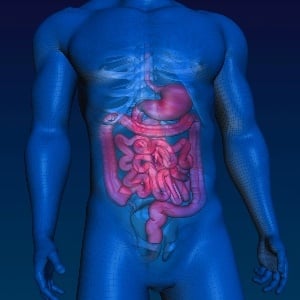
Alternative names: Inflammatory bowel disease, granulomatous colitis, Crohn's enteritis, granulomatous enteritis, regional enteritis, ileitis, ileocolitis
Crohn's disease is a chronic disorder that causes inflammation of the gastrointestinal (GI) tract, resulting in diarrhoea (frequent, loose, watery stools). It’s also known as an inflammatory bowel disease (IBD).
Another common IBD is ulcerative colitis, which can be very difficult to distinguish from Crohn’s disease. However, as the name implies, ulcerative colitis only affects the colon.
While the most common symptoms are diarrhoea, abdominal pain and weight loss, Crohn's disease can affect any part of the GI tract from the mouth to the rectum, as well as the eyes and joints.
Crohn's disease affects bowel function in a number of ways:
- The gut lining may swell, thicken and/or form scar tissue, which can lead to an obstruction (blockage).
- Ulcers may develop that can affect the gut’s ability to absorb nutrients from digested foods (malabsorption).
- Ulcers may erode and form abnormal passageways (fistulas) which, if left untreated, can be life threatening.
Crohn’s disease is treated with medicines, most of which are directed at reducing inflammation and managing the symptoms. Surgery may be required if the inflammation associated with the disease progressively causes damage to the intestines.
Crohn’s disease is a chronic condition, and you may experience periods of good health (remission) and times when symptoms are more active (flare-ups). Each case of Crohn’s is different; the disease can run a benign course with few flare-ups over your lifetime or you may have more severe disease.
Pathophysiology of Crohn’s disease
There’s ongoing research on what exactly causes Crohn’s disease. Although researchers still don’t really understand what triggers it, major advances have been made over the past few years, particularly in terms of the genetics of the disease.
Current research indicates that a combination of factors are probably responsible for causing Crohn’s disease. These include:
- Genetic make-up.
- An abnormal reaction of the immune system.
- An environmental trigger or triggers. Viruses, bacteria, diet, smoking, certain medications and stress have all been suggested as environmental triggers, but there’s no definite evidence that any one of these is the cause of Crohn’s.
Sub-types
There are several different sub-types of Crohn's disease:
1. Ileocolitis
Ileocolitis is the most common type of Crohn's. It affects part of the small intestine, called the ileum, as well as the colon. When Crohn’s disease affects the ileum and colon, you may experience considerable weight loss, diarrhoea, and cramping or pain in the middle or lower right part of the abdomen.
2. Ileitis
As the name suggests, this type of Crohn's disease affects only the ileum (the last part of the small intestine). The symptoms are the same as those for ileocolitis (i.e. weight loss, diarrhoea, cramping and pain).
3. Gastroduodenal Crohn's disease
This type of Crohn’s disease involves the stomach and duodenum (the first part of the small intestine). Symptoms include nausea, weight loss and loss of appetite. Vomiting is also a common symptom if the narrow segments of the bowel are obstructed.
4. Jejunoileitis
Here the jejunum (the second part of the small intestine, after the duodenum) is affected. Symptoms include cramps after meals, diarrhoea and abdominal pain that can become intense. Malabsorption of nutrients from food is of concern, and the formation of fistulas is more common.
5. Crohn's (granulomatous) colitis
This form of Crohn's disease only involves the colon (large intestine). Symptoms include skin lesions, joint pains, diarrhoea, rectal bleeding and the formation of ulcers, fistulas and abscesses around the anus.
6. Peri-anal Crohn’s disease
Crohn’s disease around the anus can occur on its own or at the same time as inflammation in other parts of the body. Some people notice peri-anal symptoms before they develop intestinal symptoms.
The following symptoms are commonly observed:
- Fissures (tears in the lining of the anal canal), which can cause pain and bleeding, especially during bowel movements.
- Skin tags – small, fleshy growths around the anus.
- Haemorrhoids (piles), which are swollen blood vessels in or around the anus and rectum.
- Abscesses – collections of pus that can become swollen and painful. The most common area for an abscess to form is around the anus. This can cause a fever or lead to a fistula.
- Fistulas (abnormal passageways between organs or other parts of the gut). In peri-anal Crohn’s disease, fistulas often run from the anal canal to the skin around the anus. They appear as tiny openings in the skin that leak pus or sometimes faecal matter.
7. Oral Crohn’s disease
Crohn’s disease can occasionally affect the mouth, and typically causes swollen lips and/or mouth fissures (tears). Some people with Crohn’s may develop mouth ulcers during flare-ups. However, these symptoms may also be due to nutritional deficiencies such as a lack of vitamin B12, folate and iron.
Note: There can be an overlap between these types of Crohn's disease. In some people more than one area of the digestive tract is affected.
Reviewed by Kim Hofmann, registered dietitian, BSc Medical (Honours) Nutrition and Dietetics, BSc (Honours) Psychology. December 2017.




 Publications
Publications
 Partners
Partners















